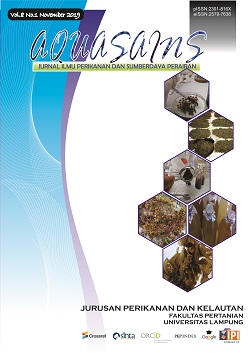POPULATION DENSITY AND DISTRIBUTION PATTERNS OF KALAMBODO MUSSEL (Anodonta woodiana) IN THE SUB WATERSHED OF LAHOMBUTI RIVER, LAHOTUTU VILLAGE, KONAWE DISTRICT SOUTH EAST SULAWESI
DOI:
https://doi.org/10.23960/aqs.v8i1.p759-768 Abstract View: 614
Abstract View: 614
Abstract
Abstrak The research was conducted in November 2018 - February 2019 in the Sub-watershed of the Lahombuti River in Lahotutu Village, Konawe Regency. The purpose of this study was to determine aspects of population density and distribution patterns of the Kalambodo (A. woodiana) in the Sub watershed of the Lahombuti tributary in Lahotutu Village, Wonggeduku District, Konawe Regency. The sampling location was determined using the purposive random sampling method. Sampling of Kalambodo (A. woodiana) was carried out at the location with the greatest abundance of A. woodiana, in the Sub watershed of the Lahombuti tributary of Lahotutu Village, on the "Main Rice Field Irrigation Channel" (diameter: ± 1,75 m, length: ± 4500 m, depth: ± 110 cm). Sampling of A. Woodiana was carried out at the same station with different spot sampling points. The Kalambodo samples were taken using a 1x1 m2 sized transect on 3 randomly assigned plots. The range of A. woodiana density per sub station is November 2018 amounting to 67-95 ind/m2, December 2018 is 41-61 ind/m2, January 2019 is 41-148 ind/m2 and February 2019 is 101- 114 ind/m2. The average density based on the period from the highest to the lowest is obtained in February 2019, January 2019, November 2018, and December 2018, which is 106.67 ind/m2, 81.33 ind/m2, 78 ind/m2, and 53 ind/m2, respectively. The distribution pattern of A. woodiana in the Sub-watershed of the Lahombuti River Basin generally shows a uniform category (Id <1), with a range of morisitha index values of 0.65-0.87.Downloads
Download data is not yet available.
Downloads
Published
2017-11-19
How to Cite
Purnama, M. F., Abdullah, A., Admaja, A. K., & Afu, L. O. A. (2017). POPULATION DENSITY AND DISTRIBUTION PATTERNS OF KALAMBODO MUSSEL (Anodonta woodiana) IN THE SUB WATERSHED OF LAHOMBUTI RIVER, LAHOTUTU VILLAGE, KONAWE DISTRICT SOUTH EAST SULAWESI. AQUASAINS, 8(1), 759–768. https://doi.org/10.23960/aqs.v8i1.p759-768
Issue
Section
Articles
License
License for Authors
Authors who publish with this journal agree to the following terms:
- Authors retain copyright and grant the journal right of first publication with the work simultaneously licensed under a Creative Commons Attribution License that allows others to share the work with an acknowledgement of the work's authorship and initial publication in this journal.
- Authors are able to enter into separate, additional contractual arrangements for the non-exclusive distribution of the journal's published version of the work (e.g., post it to an institutional repository or publish it in a book), with an acknowledgement of its initial publication in this journal.
- When the article is accepted for publication, its copyright is transferred to Aquasains Journal. The copyright transfer convers the exclusive right to reproduce and distribute the article, including offprint, translation, photographic reproduction, microfilm, electronic material, (offline or online) or any other reproduction of similar nature.
- Authors are permitted and encouraged to post their work online (e.g., in institutional repositories or on their website) prior to and during the submission process, as it can lead to productive exchanges, as well as earlier and greater citation of published work (See The Effect of Open Access).
- The Author warrant that this article is original and that the author has full power to publish. The author sign for and accepts responsibility for releasing this material on behalf os any and all-author. If the article based on or part os student’s thesis, the student needs to sign as his/her agreement that his/her works is going published.
License for Regular Users
Other regular users who want to cite, distribute, remix, tweak, and build upon author’s works, even for commercial purposes, should acknowledge the work’s authorship and initial publication in this journal, licensed under a Creative Commons Attribution License.
This license lets others distribute, remix, tweak, and build upon your work, even commercially, as long as they credit you for the original creation.
This work is licensed under a Creative Commons Attribution 4.0 International License.Copyright Transfer Statement can be downloaded here


.png)









